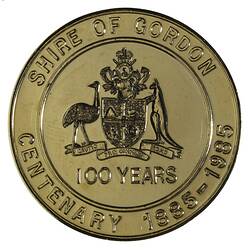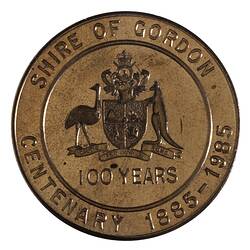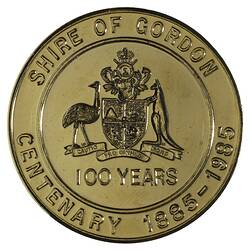The Shire of Gordon was a rural shire located north-west of Melbourne. It was named after the area's first settler, George Gordon, in 1838. Gold was discovered in the vicinity in May 1858, and the mining town of Gordon soon grew by the Moorabool River. The goldfield was also known as Gordon's. By July 1858 300 people were working on Gordon's. It was soon clear that the gold reef ran all the way to Mount Egerton. By 1860 two companies, Kangaroo Bob Reef and Parker's, were working on the Gordon end of the field. By 1863 quartz mining in the division had stagnated. Only the Parker's Reef Company was at work at the Gordon end. Quartz mining was soon wound down. However, in the mid-1860s ground sluicing was still being carried out along Parker's Gully and the banks of the Werribee River (10 miles north of Gordon). In March 1868 the mining registrar reported that a large extent of ground had been taken up, stretching north from the Egerton mine to Parker's, Kangaroo Bob and Hicks reefs at Gordon.
The Gordon Railway Station was constructed in 1879 by T. W. Cowley, on the Melbourne-Ballarat line, for the Victorian Railways.
New quartz fields in the early 1880s led to a revival of mining in the area. Local infrastructure continued to develop, supporting Gordon as a mining and agricultural centre, and the Shire of Gordon was proclaimed on 29 May 1885. Summer Hill, Shamrock and South Shamrock companies all erected mining plant, including batteries, at Moorabool West, to the north of Gordon. Throughout the 1890s, however, the Egerton-Gordon line produced very little gold. One by one its principle mines suspended or cut back operations as known reserves were exhausted.
During the 1930s depression the price of gold rose from £4 to £8 and ounce. This rise promoted a revival in gold mining throughout Victoria. In September 1933 Daniel Toohey discovered the Gordon Gold reef - 60 tons from the reef crushed at the Egerton State Battery yielded 356 ounces of gold. Only one of the companies set up to mine the gold, the Gordon Gold Company, paid dividends, and it had closed by 1936. With the demise of the Gordon Gold Mining Company in 1939, the mining of kaolin (china-clay) became the main attraction in the area.
On 19 January 1995 the Shires of Gordon, East Loddon and Korong, part of the City of Greater Bendigo and Shires of Bet Bet, Maldon and Tullaroop were unified to become Loddon Shire Council. Today the Loddon Shire Council area forms part of Victoria's Goldfields Tourist Region and incorporates the majority of the 'Golden Triangle'. Encompassing Wedderburn, Inglewood and Dunolly, the Golden Triangle is reputed to have yielded up to 80% of the world's gold nuggets.
The town of Gordon itself is today part of Moorabool Shire Council, formed on 6 May 1994. It was formerly part of the Shire of Ballan.
The Shire of Gordon issued a medal to commemorate the 1887 Jubilee of Queen Victoria.
References:
Municipal Association of Victoria website http://www.mav.asn.au/CA256C2B000B597A/HomePage?ReadForm&1=Home~&2=~&3=~, accessed 09/12/2003.
Blake, L. (1977). Place Names of Victoria.
Victorian Heritage Register http://www.doi.vic.gov.au/doi/hvolr.nsf, accessed 09/12/2003.
Heritage Victoria website http://heritage.vic.gov.au/PDFS/HGMS/plotted_histories/south_west_victoria/MountEgerton&Gordon.pdf, accessed 09/12/2003.
More Information
-
Keywords
-
Localities
-
Authors
-
Article types



